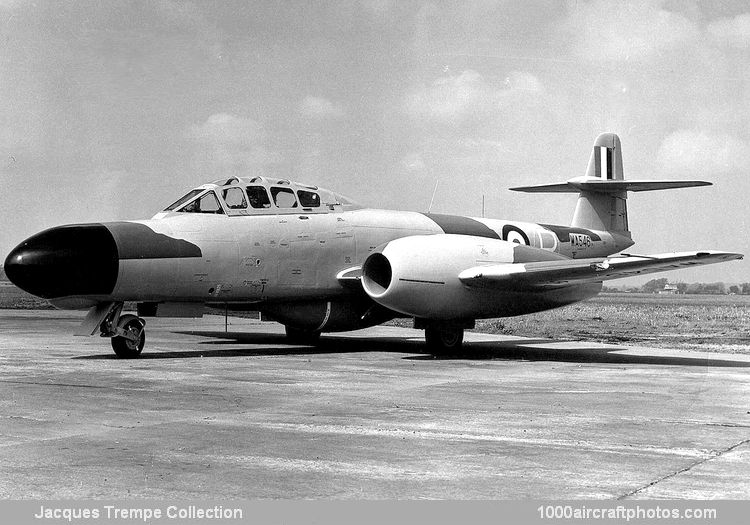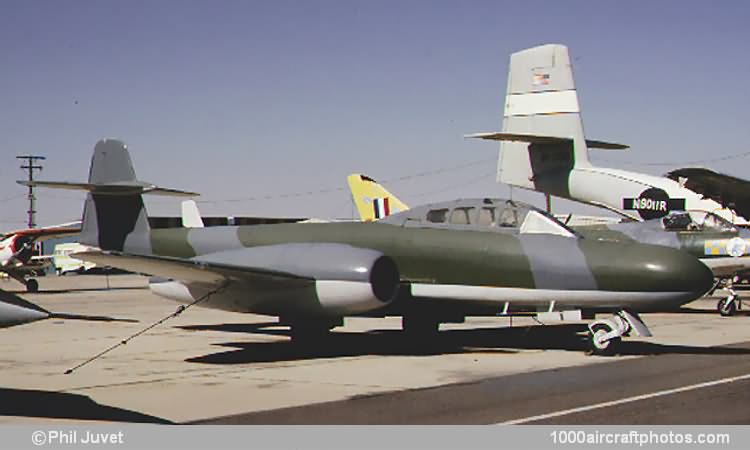Source unknown, via Lester A. Lovelock
01/31/2012. Remarks by
Johan Visschedijk: "The issue in January 1947 of Specification F.44/46 for a two-seat, twin-engined night fighter produced a number of proposals, but none of the designs met the RAF requirements, largely through a lack of knowledge of high-speed flight and associated problems, with the result that Glosters were asked to develop the Meteor for this role as an interim measure.
Gloster had been concerned with extensive tests of airborne radar in Meteor F.Mk.3s and F.4s in 1946 and, following the failure of their F.44/46 proposal, undertook several design studies including one in October 1949 embodying reheated Derwent engines and broad-chord wings with marked sweepback on the outer panels. However the design office was heavily overloaded with work on the Meteor F.Mk.8 and the Javelin, and in 1949 it was decided that development and production responsibility for the night fighter should be transferred to Armstrong Whitworth.
The aerodynamic configuration of this Meteor fighter, designated NF.Mk.11, was flight tested on the fourth production T.Mk.7 (s/n VW413), which first flew in October 1949.
G.47 Meteor NF.Mk.11 (WA546) (
Jacques Trempe Collection)
The first true prototype G.47 Meteor NF.Mk.11 WA546 was first flown on May 31, 1950, by Eric Franklin. In appearance the Meteor NF.Mk.11 featured the T.Mk.7's cockpit, the F.Mk.8's tail unit and the long-span wings similar to the PR.Mk.10; to this was added a lengthened di-electric nose containing the scanner for the Mk.Mk.10 AI radar.
A major modification was the re-positioning of the four 0.787 in (20 mm) cannon in the wings, outboard of the Derwent engines, together with 160 rounds of ammunition for each cannon. Another important modification was the introduction of a pressure cabin in what was virtually a T.Mk.7 front fuselage, and, to achieve this, all the structure between the nose wheel bulkhead and front spar bulkhead was sealed. The differential pressure was identical to that on Meteor F.Mk.8s, FR.Mk.9s, and PR.Mk.10s.
The AI radar scanner installation presented quite a formidable aerodynamic problem, for it was discovered that, with the fuselage lines decided, the bottom bearing, on which the scanner swung, protruded below the lower surface of the nose. A great deal of flight-test work was required before the best fairing shape was achieved. The power demand on the aircraft's electrical system was considerably more than on earlier Meteors and power was supplied by two 28 volt 6 kilowatt engine-driven generators charging two 12 volt accumulators.
The first production Meteor NF.Mk.11 (s/n WD585) was delivered to No. 29 Squadron early in 1951 and the last aircraft left Baginton in May 1954. A total of 341 NF.Mk.11s, including three prototypes, were produced, these aircraft served with 15 RAF squadrons and No. 228 OCU.
Because of its high performance, wing strength, two seats, and ability to carry a considerable load of electronic equipment in its long nose, the NF.Mk.11 was adapted for many experimental programs in connection with the development of guided weapons and guidance systems, jettisonable wing tip tank installations, and radar dart targets. The was used as a chase aircraft, as a flying test bed for aerodynamic improvements.
G.47 Meteor TT.Mk.20 (N94749) (
Jacques Trempe Collection)
A number of Meteor NF.Mk.11s were also converted to TT.Mk.20 standard and were used to tow high-speed non-radar or radar-responsive targets stowed internally.
The last twenty produced for the RAF (s/n WM384 to WM403) were diverted on the production line to the Royal Danish AF and the first four (s/n 501 to 504) of these were delivered on November 28, 1952; the remainder (s/n 505 to 520) were all in Denmark by the following March. These aircraft were operated by No. 723 Squadron. In 1958-1959 all NF.Mk.11s were withdrawn from use, although six of these (s/n 504, 508, 512, 517, 518, 519) were converted to TT.Mk.20 target-tugs by Armstrong Whitworth Aircraft Ltd at Coventry.
In 1962 the six TT.Mk.20s were also withdrawn from use, however, four (s/n 508, 512, 517, 519) were registered in Sweden as SE-DCH, SE-DCF, SE-DCG, and SE-DCI respectively, and were, while still owned by the Danish Government, operated by Svensk Flygtjänst AB (Swedish Flight Service) for target-towing duties in Denmark, until 1966, when SE-DCG and SE-DCI were scrapped.
SE-DCF and SE-DCH were then sold and an attempt was made to put them on the German register, registrations D-CAKU and D-CAKY being reserved but reportedly not taken up. In 1969 both were flown to Gosselies, Belgium, however, as it was suspected they were to be flown out of Europe to Biafra, for use in the civil war in Nigeria at the time, they were grounded. After 19 years of storage in the open in Belgium, SE-DCF and SE-DCH ended up in the Castle Museum Savigny-lès-Beaune in Burgundy, France.
A total of 32 Meteor NF.Mk.11s (all ex-RAF aircraft, some factory fresh) were delivered to the French AF between January 1953 and April 1955 and serialed 10 to 41, were operated by the 30th Fighter Squadron, the first all-weather fighter unit in the French AF to re-equip with jet aircraft. One NF.Mk.11 was fitted with two SFECMAS ARS 600 ramjets, installed one under each wing, in addition to its two Derwent 8 engines. A number of other NF.Mk.11s were subsequently operated by the Centre d'Essais en Vol, Bretigny, for various flying duties.
In 1957, 24 Meteor NF.Mk.11s were the subject of a Government to Government deal with Belgium, all the aircraft being ex-RAF reserialed EN-1 to EN-24. These aircraft were issued to No. 10 and No. 11 Squadrons of No. 1 Fighter Interceptor Wing at Beauvechain and served with this wing until 1959.
The pictured aircraft was delivered to the RAF on October 14, 1952. Within four years it deregulated to static exhibition duties, as on June 18, 1956 it was delivered to the No. 58 MU, 43 Group Exhibition Pool at Honington."



